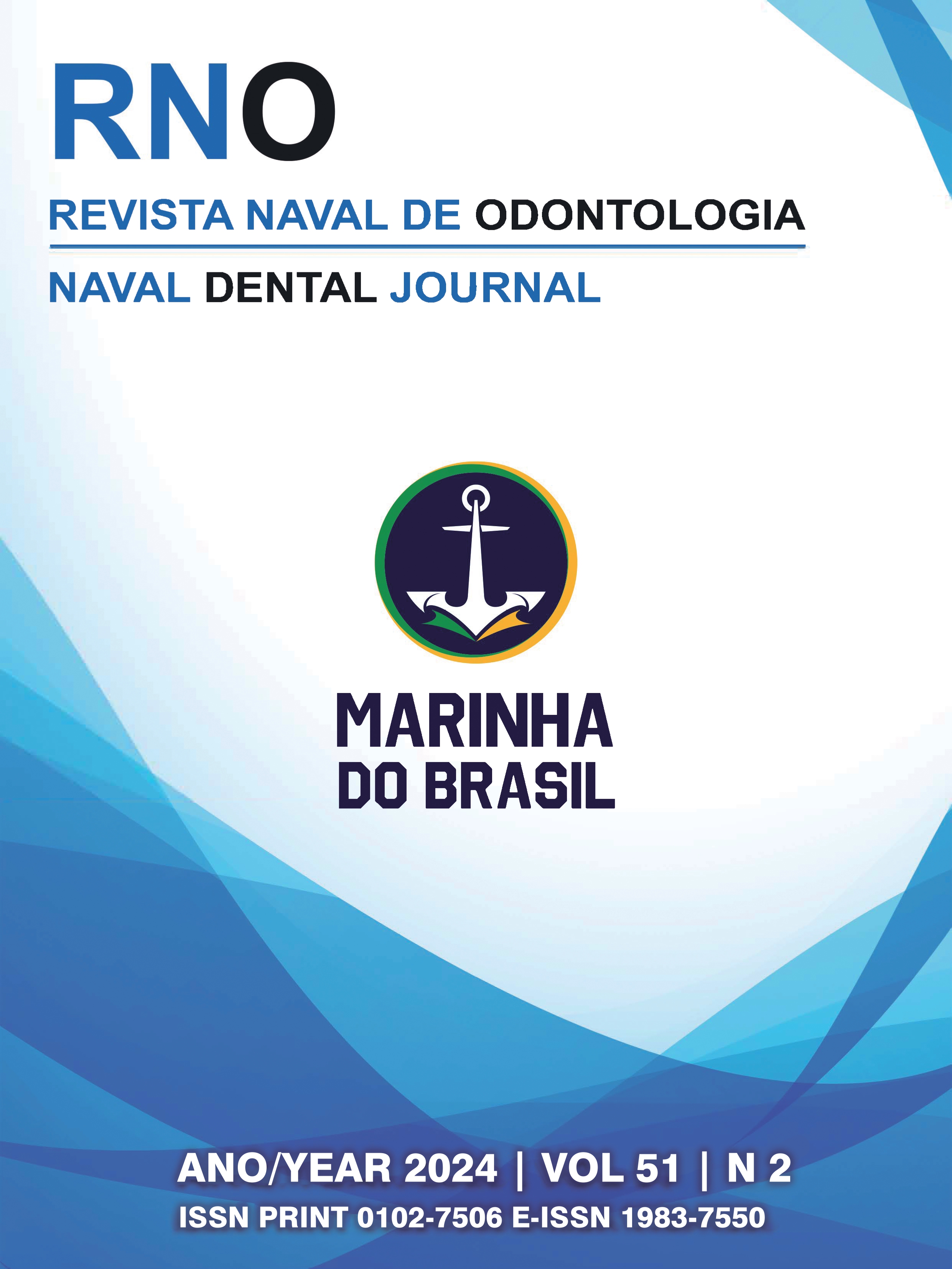IMPACT OF THE COVID-19 PANDEMIC ON THE INCREASE IN EMERGENCIES FOR TEMPOROMANDIBULAR DYSFUNCTIONS: A CROSS-SECTIONAL STUDY
Main Article Content
Abstract
COVID-19 is a disease that has a wide clinical spectrum thar ranges from completely asymptomatic conditions to severe pulmonary infection. The social isolations recommended by health authorities, despite being necessary to prevent the spread of the disease, may had have a negative impact on the mental health of the population with an increase in the number of cases of anxiety, depression a d other psychological disorder. In this context, temporomandibular dysfunction (TMD), a multifactorial disease that including the psychological factor, may have worsened after the start of the pandemic period. The object of this study was to verify whether or not there was a worsening of TMD symptoms during the pandemic period and what they were. The research was carried out on patients treated at the TMD clinic of Odontoclínica Central da Marinha (OCM), located in the city of Rio de Janeiro-RJ, Brazil. A retrospective cross-sectional study was carried out by collecting data from 784 electronic medical records of patients aged of 12 and over, before the pandemic, 2019, and during the pandemic, in 2020, according to the eligibility criteria. The results obtained through statistical analyses revealed a worsening of TMD symptoms during the pandemic period. There was an increase in emergency consultations and cases of muscle and join pain. It was concluded that the worsening of TMD symptoms may be associated with the negative impact of the pandemic on the mental health of OCM patients.
Article Details

This work is licensed under a Creative Commons Attribution-NonCommercial-NoDerivatives 4.0 International License.
References
2. Sena MF, Mesquita KS, Santos FR, Silva FW, Serrano KV. Prevalence of temporomandibular dysfunction in children and adolescents. Rev Paul Pediatr. 2013;31(4):538–545.
3. Zakrzewska JM. Temporomandibular disorders, headaches and chronic pain. J Pain Palliat Care Pharmacother. 2015;29(1):61–63.
4. Magnusson T, Egermark I, Carlsson GE. A longitudinal epidemiologic study of signs and symptoms of temporomandibular disorders from 15 to 35 years of age. J Orofac Pain. 2000;14(4):310–319.
5. Conti PC, Pinto-Fiamengui LM, Cunha CO, Conti AC. Orofacial pain and temporomandibular disorders: the impact on oral health and quality of life. Braz Oral Res. 2012;26 (Suppl 1):120–123. 3.
6. Zakrzewska JM. Temporomandibular disorders, headaches and chronic pain. J Pain Palliat Care Pharmacother. 2015;29(1):61–63.
7. Suvinen TI, Reade PC, Kemppainen P, Könönen M, Dworkin SF. Review of aetiological concepts of temporomandibular pain disorders: towards a biopsychosocial model for integration of physical disorder factors with psychological and psychosocial illness impact factors. Eur J Pain. 2005;9(6):613–633
8. Graff-Radford SB. Temporomandibular disorders and headache. Dent Clin North Am. 2007;51(1):129–144
9. Umakanthan S, Sahu P, Ranade AV, Bukelo MM, Rao JS, Abrahao-Machado LF, Dahal S, Kumar H, Kv D. Origin, transmission, diagnosis and management of coronavirus disease 2019 (COVID-19). Postgrad Med J. 2020 Dec;96(1142):753-758.
10. Umakanthan S, Sahu P, Ranade AV, Bukelo MM, Rao JS, Abrahao-Machado LF, Dahal S, Kumar H, Kv D. Origin, transmission, diagnosis and management of coronavirus disease 2019 (COVID-19). Postgrad Med J. 2020 Dec;96(1142):753-758.
11. Ohrbach R, editor. Diagnostic Criteria for Temporomandibular Disorders:
Assessment Instruments. Version 15May2016. www.rdc-tmdinternational.org
Accessed on Sept 4th, 2024.
12. Sójka A, Stelcer B, Roy M, Mojs E, Pryliński M. Is there a relationship between psychological factors and TMD? Brain Behav. 2019 Sep;9(9):e01360. doi: 10.1002/brb3.1360. Epub 2019 Jul 24. PMID: 31339236; PMCID: PMC7649956.
13. Vindegaard N, Benros ME. COVID-19 pandemic and mental health consequences: Systematic review of the current evidence. Brain Behav Immun. 2020 Oct;89:531-542.
14. Emodi-Perlman A, Eli I, Smardz J, Uziel N, Wieckiewicz G, Gilon E, Grychowska N, Wieckiewicz M. Temporomandibular Disorders and Bruxism Outbreak as a Possible Factor of Orofacial Pain Worsening during the COVID-19 Pandemic-Concomitant Research in Two Countries. J Clin Med. 2020 Oct 12;9(10):3250.
15. Peixoto KO, Resende CMBM, Almeida EO, Almeida-Leite CM, Conti PCR, Barbosa GAS, Barbosa JS. Association of sleep quality and psychological aspects with reports of bruxism and TMD in Brazilian dentists during the COVID-19 pandemic. J Appl Oral Sci. 2021 Jul 23;29:e20201089.
16. de Melo Júnior PC, Aroucha JMCNL, Arnaud M, Lima MGS, Gomes SGF, Ximenes R, Rosenblatt A, Caldas AF Jr. Prevalence of TMD and level of chronic pain in a group of Brazilian adolescents. PLoS One. 2019 Feb 8;14(2):e0205874.
17. Yadav S, Yang Y, Dutra EH, Robinson JL, Wadhwa S. Temporomandibular Joint Disorders in Older Adults. J Am Geriatr Soc. 2018 Jul;66(6):1213-1217. doi: 10.1111/jgs.15354. Epub 2018 May 2. PMID: 29719041; PMCID: PMC6699643.
18. Moharrami M, Bohlouli B, Amin M. Frequency and pattern of outpatient dental visits during the COVID-19 pandemic at hospital and community clinics. J Am Dent Assoc. 2022 Apr;153(4):354-364.e1.
19. Colonna A, Guarda-Nardini L, Ferrari M, Manfredini D. COVID-19 pandemic and the psyche, bruxism, temporomandibular disorders triangle. Cranio. 2021 Oct 15:1-6.
20. Minervini G, Franco R, Marrapodi MM, Mehta V, Fiorillo L, Badnjević A, Cervino G, Cicciù M. The Association between COVID-19 Related Anxiety, Stress, Depression, Temporomandibular Disorders, and Headaches from Childhood to Adulthood: A Systematic Review. Brain Sci. 2023 Mar 12;13(3):481.
21. Yap AU, Sultana R, Natu VP. Stress and emotional distress: their associations with somatic and temporomandibular disorder-related symptoms. Psychol Health Med. 2022 Apr;27(4):876-887. doi: 10.1080/13548506.2021.1908571. Epub 2021 Apr 20. PMID: 33879010.
22. Saczuk K, Lapinska B, Wawrzynkiewicz A, Witkowska A, Arbildo-Vega HI, Domarecka M, Lukomska-Szymanska M. Temporomandibular Disorders, Bruxism, Perceived Stress, and Coping Strategies among Medical University Students in Times of Social Isolation during Outbreak of COVID-19 Pandemic. Healthcare (Basel). 2022 Apr 15;10(4):740.

